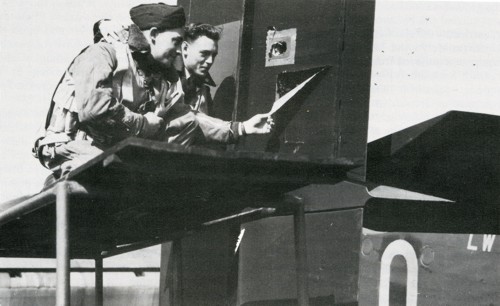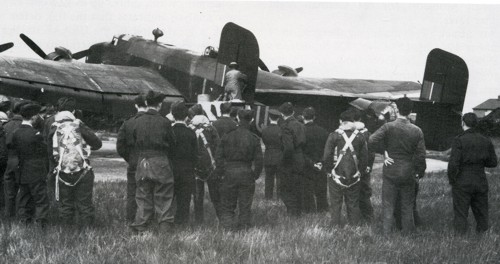
 |
The source for the text of this page is: Air Ministry Bulletin No.14238. 10 June 1944 - BEES IN A BOMBER: Q FOR QUEENIE
A swarm of bees searching for a home decided to take up their quarters in the port rudder of 'Q' for Queenie, a Halifax bomber at an airfield in the North of England. Queenie was on operations that night, while her crew were quite ready for the Germans, they were not prepared to take off with a flight of intruders already inside the bomber. The flight sergent in charge of the ground staff was called and after discussion on how to get rid of the swarm, someone remembered that there was a man in the next village who kept bees. So he was called in to do the job, and 'Q' for Queenie took off that night to sing the Germans - but minus the bees.

Q-Queenie's air gunners Sgt Hugh Sloan and Sgt Jack Clague.

Ground and aircrews watch as the apiarist dislodges the bees.
Source:Air Ministry Bulletin No.14238
There is a tragic postscript to this story. On 18th July 1944 578 Squadron were on ops; A short daylight op to Caen.
Victor Starkoff and his crew had finished their tour of operations but volunteered to do one more op. LW794 LK-Q-Queenie had been their aircraft throughout their tour and after were airborne for about an hour when the starboard inner caught fire. All attempts to control the blaze were unsuccessful so the pilot ordered the crew to abandon the aircraft. Only the rear gunner Sergent Hugh Sloan was able to do so before the machine turned upside down and plunged vertically into Carpenters wood near Maidenhead where it exploded as it still had a full bomb load. No trace of the crew was found and their names are recorded at the RAF memorial to the missing at Runnymede.
The air and groundcrew were very proud of their aircraft and 578sqn groundcrew had a respected reputation for their maintainance standards. So there has been suspicions of sabotage in this case. However we will never know.
It was doubly tragic as this crew had officially finished their tour and it was a daylight op so the crash was witnessed by the other squadron crews.
In 1998 Hugh Cawdron had a memorial made and it now sits beside the largest impact crater (some fifteen feet deep and 100 feet across) in a woodland glade in Carpenters wood. Information about the memorial can be found in the memorials section:
http://www.578squadron.org.uk/memorials/carpenter.html